Unit II - Genetics
Ch 4.1 - The Nature of Heredity
Genetic Material
Genetics: the branch of biology dealing with heredity and the variation of inherited characteristics
\
DNA (Deoxyribonucleic Acid): a molecule that carries genetic information in cells, and contains instructions for making all the proteins\
Gene: a segment of a DNA molecule that codes for a particular trait found at a specific location of a chromosome\
Genome: An organism’s complete set of DNA (including genes and non-coding regions)\
Locus: the location of a gene on a chromosome
Genetic material is a term used to describe information in an organism that stores genetic information
- genetic info is contained in a molecule of DNA in a chromosome
DNA
DNA contains a sugar called deoxyribose, phosphate (PO4), and a nitrogen-containing base
\
Nucleotides include Adenine, Thymine, Cytosine, and Guanine
Sugar and phosphate groups form the exterior backbone of the molecule. The nitrogenous bases pair up and bond to join the two nucleotide chains
Adenine + Thymine
Guanine + Cytosine
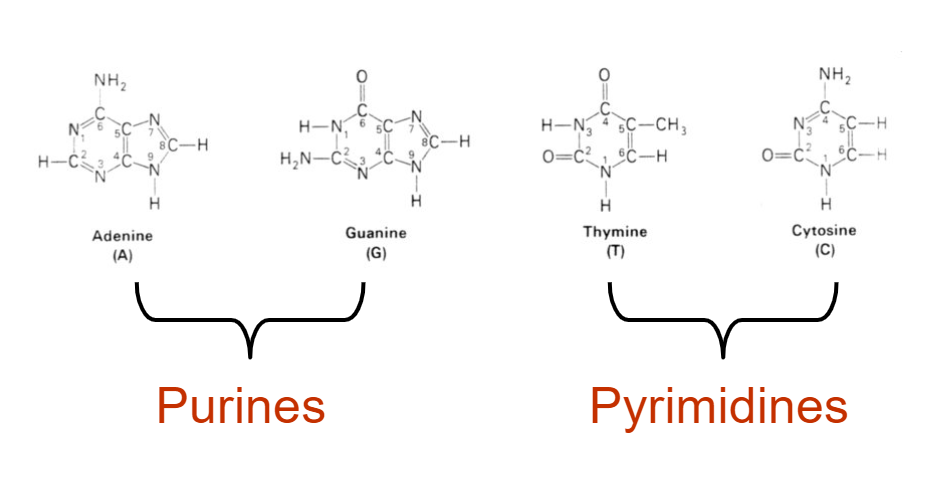
DNA is shaped like a ladder coiled into a helix shape
- the DNA double helix
Each DNA molecule is composed of hundreds of chemical subunits that act as a set of chemical instructions for the cell → occur as distinct sequences of information along the DNA → gene
- units of heredity, and are made up of segments of DNA that code for specific protein → provide a template to assemble amino acids (building blocks of proteins)
- occupy a specific locus on a chromosome
DNA is found free-floating in the cytoplasm - prokaryotic cells
DNA is found in the nucleus - Eukaryotic cell
Chromatin
Nucleosomes - the DNA-histones complexes formed from the coiling of DNA around bundles of eight/nine histone proteins
DNA is packaged with proteins to form chromatins in eukaryotes → forms nucleosomes
When the cell is not diving the DNA is arranged as:
- Euchromatin - Loose DNA bound to nucleosomes → actively being transcribed to make proteins
- Heterochromatin - areas where nucleosomes are more tightly compacted and where DNA is inactive
Chromosomes
Chromosomes: formed by condensing and compacting chromatin during cell division, made of sister chromatids joined at the centromere bound by cohesion proteins
\
Polyploid: having more than two sets of chromosomes, many plants are polyploids
Different species have different numbers of chromosomes
- human - 46 chromosomes/ 23 pairs
- dog - 78 chromosomes/ 39 pairs
- mosquito - 6 chromosomes/ 3 pairs
- banana - 22 chromosomes/ 11 pairs
Asexual Reproduction
Asexual reproduction: the production of offspring from a single parent, the genetic makeup of the offspring is identical to that of the parent
While asexual reproduction can vary from species to species, it almost always involves cell division → two new cells that are genetically identical to one another and the parent cell
Pro
→ parent organism doesn’t have to seek mate/perform specialized mating behaviors/possess special anatomy
Sexual Reproduction
Sexual reproduction: the production of offspring from the fusion of two sex cells, the genetic makeup of the offspring is different from that of either parent
Offspring produced by sexual reproduction are not genetically identical to either of their parents but obtain half of their genetic information from each of the two parent
Pro
→ provide some insurance/flexibility in the future
→ is able to have offspring that survive through the natural selection
Ch 4.2 - Asexual Reproduction: Mitosis
Asexual reproduction is more common among unicellular organisms but in plants and fungi as well
Modes of Asexual Reproduction
Fragmentation: method of asexual reproduction in which a piece/body fragment of the parent organism develops into a mature individual
→ Budding
- extensions grow when growing condition is favorable → detach and become new genetically identical individuals
→ Giving birth to only females
- Aphids only give birth to females → which can increase the number of female-only population
- Aphids only give birth to males during spring which can produce sexually → giving genetic diversity
→ Fragmentation
- parts of the growing fungi break off and grow independently
Mitosis - Cell division
Mitosis: the process by which a eukaryotic cell divides the genetic material in its nucleus into two new identical nuclei
\
Interphase: portion of the cell cycle between mitotic divisions when the genetic material (in form of chromatin) is duplicated\
Chromatin: the tangled strands of NDA and protein within a eukaryotic cell\
Sister chromatid: identical copy of a single chromosome that remains attached to the original chromosome at the centromere\
Cytokinesis: the process in which a eukaryotic cell divides its cytoplasm into two new daughter cells
Cell Cycle
Interphase (growing stage) takes up about 90% of the cell cycle
- G1 - cell growth
- Synthesis - chromosome duplication/DNA Replication
- G2 - growth, and preparation for cell division, DNA is checked for error
- *G0 - temporarily/permanently leave the cell cycle and enter a rest phase
The mitotic phase involves 2 phases
- Mitosis - a division of the nucleus and genetic material
- Cytokinesis - a division of cytoplasm and cell membrane
→ chromatin condense and coils into chromosomes, which are sister chromatids joined together at the centromere
Mitosis
Interphase > Prophase> Prometaphase > Metaphase > Anaphase > Telophase > Cytokinesis
- Interphase
- chromatin is enclosed in the nuclear envelope with visible one or more nucleoli
- two microtubule centers somehow exist outside the nucleus, containing a pair of centriole in animal cells
- DNA is replicated and is un-condensed in the nucleus
- Prophase
- nuclear membrane starts to dissolve
- chromatin condenses into chromosomes
- centriole separate and move to opposite poles of the cell → anchor the chromosomes to the spindle fibers
- the mitotic spindle is assembled at centrosomes and moves to opposite ends of the cell
- Prometaphase
- nuclear envelope breaks down
- nucleoli disappear
- chromosome connect to spindle apparatus fibers and begin to show motility
- Metaphase
spindle fibers begin to align the centromere across the middle of the cell between the spindle’s two poles → chromosome is pulled towards the center
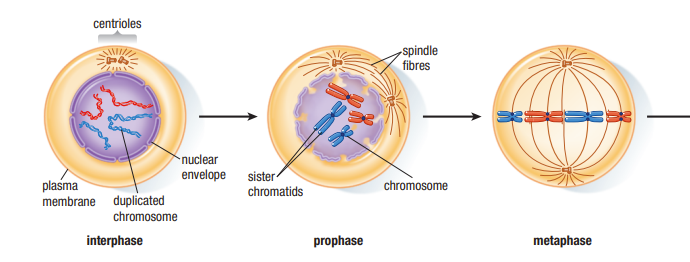
- Anaphase
- cohesion that binds the sister chromatids together at the centromere breaks down
- the microtubules connected to the chromosomes shorten → chromosomes are pulled to opposite poles
- non-kinetochore spindle fibers lengthen → cell elongate
- Telophase
nuclear membrane formed around the chromosomes
→ two nuclei form
→ chromosomes disperse into chromatin
nucleoli reappear
the mitotic spindle breaks down
- Cytokinesis
cytoplasm is divided to form two new daughter cells
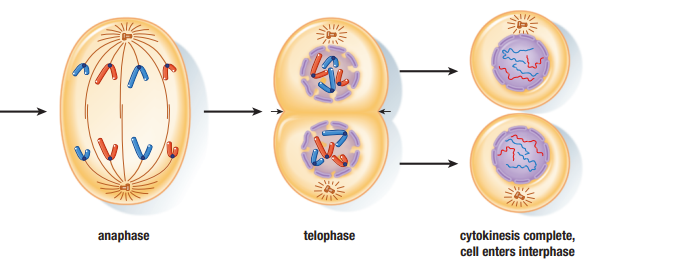
Cytokinesis
- Animal - Cleavage Furrow
→ the ring that is formed by the microfilament between the newly formed nuclei pulled the plasma membrane into the center → the cell divides into 2
- Plants - Cell Plate
→ the vesicle fuse and form a cell plate after moving from the Golgi bodies to between the nuclei → becomes the plasma membrane for the two new daughter cells
Microtubule Organizing Centers and Chromosome Movement
Microtubules: protein fiber responsible for various types of movement in the cell, including the movement of chromosomes during mitosis
\
Mitotic Spindle: macromolecular machine that segregates the chromosomes to two daughter cells during mitosis, also include other microtubules that overlap at the center of the spindle and do not attach to the chromosomes\
Astral Microtubule: the shorter microtubules that anchor centrosomes at the poles of the cell\
Kinetochore Microtubules: the longer microtubules that attach to the chromosomes
The centrosomes (or Microtubule Organizing Centers) move apart to the opposite poles → microtubules (spindle fibers) develops from each MTOC
Microtubules are dynamic proteins that grow/shrink in response to tubulin subunits
→ the assembly of spindle microtubules occurs with polarity between centrosomes (-) and the growing microtubules (+)
Kinetochore microtubules connect to the kinetochore in the centromere and tugs → chromosomes move back and forth towards one pole and another
Microtubules shorten as tubulin units uncoupled at their chromosome ends during anaphase
Polar microtubules form opposite poles that overlap and push against each other → elongate the cell
Cloning
Cloning: the process of producing one individual that is genetically identical to another using a single cell/tissue
\
Biotechnology: the use and modification of organisms for applications in engineering, industries, and medicine
Plant Cloning
- by growing individual root cells in a nutrient-rich medium containing plant hormones → cells return to an undifferentiated state
→ used to produce strains of plants with identical characteristics
Animal Cloning
- by fusing the egg cell (the nucleus is removed) and the adult body cell obtained from another organism → the egg cell contains the nucleus from the adult body cell → egg is cell is then triggered to divide and grow into an embryo
→ cloned animals typically do not live as long as normal individuals and suffer from health complications
Applications and Implications of Cloning
- to yield a more significant benefit and yields by cloning parents that are of the highest quality
→ cloned organisms may be very expensive to produce and maintain
→ some consumers avoid purchasing cloned products as they feel they are unethical
→ some parents will have high vulnerability to diseases and the clones will be uniform with the chances being prone to diseases
Genetically Modified Organisms
Genetically Modified Organism: an organism in which the genetic material has been altered using genetic engineering techniques
GMOs often carry genes that originate in a different species → exhibit some of the characteristics of the gene-donor species
bacteria, safflower, and yeast - to contain copies of the human genes that code for insulin
→ make commercial insulin
GM goats - with genes from golden orb spiders
→ produce silk protein to use to make high-strength “spider web” fiber
GM bananas - with genes for the production of a hepatitis vaccine
→ make vaccines readily available in developing countries
GM pigs - with genes involved in the production of omega-3 fatty acids
→ produce pork-based products with “healthy” fats
GM potatoes - with genes with altered starch
→ produce starch that is more suitable for industrial applications such as the production of biodegradable “eco-plastics”
Cloning Endangered Species
Cloning provides an alternative to save endangered species that are extremely difficult to breed in captivity
- primary obstacle is the need for DNA which is usually not available
- there is no guarantee for long-term survival → lack of genetic variability → vulnerable to environmental change and diseases
Ch 4.3 - Sexual Reproduction: Meiosis
Gamete: a sex cell, including sperm cells in males and eggs cells in females
\
Fertilization: the formation of a zygote by joining together two gametes\
Zygote: a cell produced by the fusion of two gametes\
Offspring produced from sexual reproduction inherit genetic information from two parents → genetically different from both parents\
Sexual reproduction involved the formation of haploid gametes and fertilization to form a zygote
Modes of Sexual Reproduction
bread mold fungus - ‘+’ & ‘-’ individuals produce gametes
→ gametes fuse and form a zygote
willow tree - the male tree produces male pollen grains and the female tree produces female eggs
→ insect pollinate “pussy willow” flowers
giant clam - young male clams produce sperm and change to female and produce egg cells once maturity
→ external fertilization - sex cells are released in the open water
Earthworms - hermaphrodites with both sperm and egg
→ two worms exchange sperm and fertilize each other’s eggs
parrot fish - males produce sperm and females produce egg cells
→ sperms are released over eggs in water
Canadian goose - males produce sperm and females produce eggs
→ internal fertilization
Sexual Reproduction
Chromosomes in human cells
Human somatic cells (cells that are not gamete) have 23 pairs of chromosomes → a total of 46 chromosomes
- two chromosomes in each pair are homologous → include one chromosome from each parent → same length and carry genes controlling the same inherited traits
Sexual Reproduction
Haploid (n): cells with one set of chromosomes that are produced by meiosis, usually gametes
\
Diploid (2n): cells with two sets of chromosomes
→ produce genetic variation by combining the genes of two parents
→ must produce gametes to produce offspring which are produced via meiosis
- two gametes combine to produce a zygote during fertilization → alternate with mitosis to maintain chromosome number
Meiosis (brief)
Meiosis: a two-stage cell division in which the resulting daughter cells have half the number of chromosomes as the parent cell, resulting in the formation of gametes/spores
\
Homologous chromosomes: matching pairs of chromosomes, similar in size and carry information of the same genes
Meiosis involves two stages of cell division that have phases similar to those in mitosis
Mitosis - chromosome number of the daughter cells is the same as that of the parent cell (46) and results in 2 daughter cells
Meiosis - the chromosome number of the daughter cell is half that of the parent cell (23) and results in 4 daughter cells
→ eg - a human cell containing 46 chromosomes (diploid) that undergoes meiosis will produce gametes that have 23 chromosomes each (haploid)
→ offspring receives genetic material from each parent in the form of haploid gametes
- 23 chromosomes received by one parent are matched by the 23 chromosomes received from the other parent that are homologous
Fertilization occurs when a haploid sperm cell (n = 23) units with a haploid egg cell (n = 23) to form a diploid zygote (2n = 46) → zygote begins growth, mitotic cellular division, and cell specialization → mature multicellular individual
Meiosis I - reduction division
Interphase I > Prophase I > Metaphase I > Anaphase I > Telophase I / Cytokinesis I
\
Tetrad: a pair of homologous chromosomes with two sister chromatids each\
Synapsis: the physical pairing up of homologous chromosomes during Prophase I\
Crossing over: the exchange of chromosome segments between homologous pairs during synapsis
1a. Interphase I
- DNA is replicated to form homologous chromosomes
2a. Prophase I
- chromosomes start to shorten and thicken and joined at the centromere and form sister chromatids → come together in homologous pairs and form a tetrad structure through synapsis
- crossing over occurs in chiasmata due to the breaking and reattaching of intertwined chromatids → recombination of genetic information between non-sister chromatids of a homologous pair →gives rise to increased genetic variation
3a. Metaphase I
- tetrads migrate toward the center of the cell and align their centromeres across the middle of the cell
- independent assortment may occur - chromosomes line up and separate randomly to increase genetic variation
4a. Anaphase I
- homologous chromosomes move to opposite poles of the cell
- only one chromosome from each homologous pair will be found in each new daughter cell
- sister chromatids remain attached at the centromere
5a. Telophase I & Cytokinesis
- nuclear membranes begin to form around the chromosomes at each end of the cell and begin to divide
- two haploid daughter cells are produced, each containing only one pair of the original chromosomes
→ interphase occurs between meiosis I and Meiosis II for some species, or none
→ chromosomes do not replicate between meiosis I and II since chromosomes are already existing in replicated forms
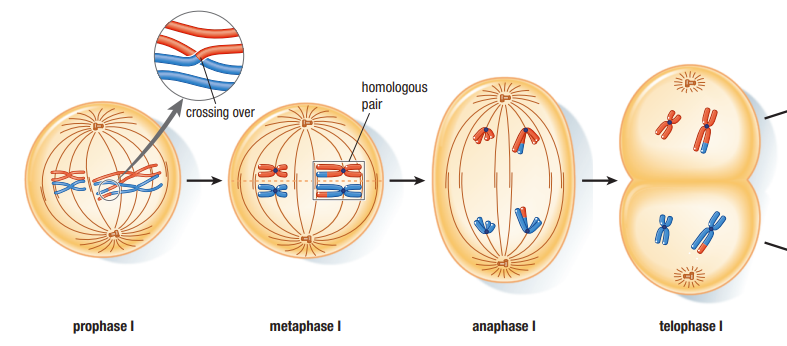
Meiosis II
Prophase II > Metaphase II > Anaphase II > Telophase II / Cytokinesis II
1b. Prophase II
- centrioles and spindle fibers begin to form
- nuclear membrane and nucleolus disappear
2b. Metaphase II
- chromosomes line up single file along the equator while remaining attached by their centromeres
3b. Anaphase II
- sister chromatids separate and move to opposite poles of the cell
- nuclear membrane begins to form around the chromosomes
4b. Telophase II / Cytokinesis II
Cytokinesis occurs and cells divide into 4 haploid daughter cells
cells are genetically different from one another
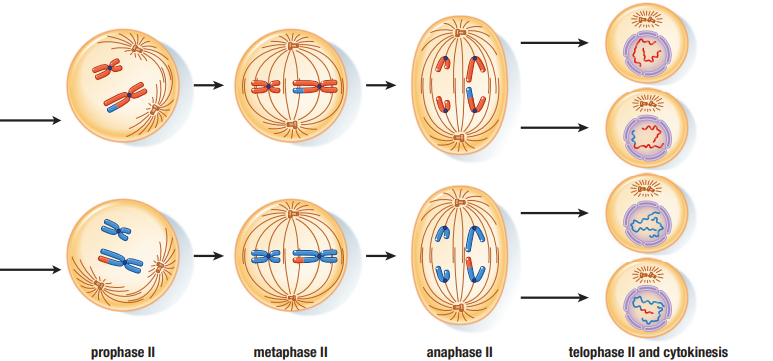
Random Assortment of Homologous Chromosomes
Chromosomes in each pair are assorted independently when haploid daughter cells received only one chromosome from each pair during Anaphase I
→ daughter cell receive either chromosome of each homologous pair
Gametogenesis
Gametogenesis: the production of gametes in animals
\
Spermatogenesis: the production of mature sperm cells\
Oogenesis: the production of mature egg cells\
Karyotype: the chromosomes of an individual that have been sorted and arranged according to size and type
Spermatogenesis
- produces four equal haploid sperm with just a nucleus, mitochondria, and flagellum
- sperm production is completed from beginning to end without a pause
→ sperm cells must be highly motile and be able to swim to an egg
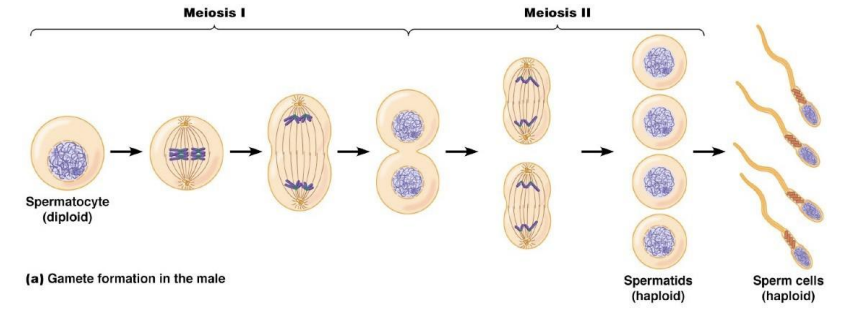
Oogenesis
- only one large egg cell with all organelles and cytoplasm is produced and 3 polar bodies are produced (they die) → source of cytoplasm for the zygote
- all egg cells produced are present at birth and suspended in Prophase I → one egg cell completes meiosis and is released
→ more advantageous to contain a large supply of nutrients in the cytoplasm → fuel future cell divisions in the event that the egg cell becomes fertilized

Sex Chromosomes and Sex Determination
Sex chromosomes: chromosomes that differ in males and females of the same species, the combination of sex chromosomes determines the sex of the offspring
\
Autosomes: non-sex chromosomes
XX / XY
mammals, some insects
→ XX - female
→ XY - males
ZW / ZZ
birds
→ ZW - females
→ ZZ - males
Temperature
turtles, crocodiles
→ warm temperature where the egg is kept - female
→ cool temperature where the egg is kept - male
Age
some feesh and mollusks
→ born male, and change into a female as the feesh mature
Social structure
some feesh
→ all young feesh are females, and the large females change into males when dominant males dies
Fertilization - haploid/diploid
bees, ants, wasps
→ diploid eggs - females
→ haploid eggs - male
Infection
some insects
→ variable - infected individuals develop into female
None
earthworms and other hermaphroditic organisms
→ all individuals have both male and female reproductive organs
Meiosis and Sexual Life Cycles
Diploid-Dominant Life Cycles
- meiosis produces gametes which undergo no further cell division before fertilization → only haploid cells in animals
Haploid-Dominant Life Cycle
- zygote produce haploid cells by meiosis → grows into a haploid multicellular organism
Alternation of Generation
- Sporophyte makes haploid spores → grows into a gametophyte → make haploid gametes → form a diploid sporophyte after fertilization
Ch 4.4a - Embryonic Development
Stages of Embryonic Development
Embryonic development consists of three stages: cleavage, gastrulation, and organogenesis
\
Cleavage: the rapid mitotic cell division of the zygote that occurs immediately after fertilization\
Gastrulation: a process that involves the rearrangement of the blastula into a three-layered embryo called a gastrula\
Organogenesis: the process by which cells continue to differentiate, producing organs from the three embryonic germ layers
The zygote will divide and give rise to all cells that make up a multicellular organism
Cleavage gives rise to a fluid-filled ball of cells with a cavity called a blastocyst → implants itself into the wall of the uterus → the cells on the end called the inner cell mass develop into the embryo → the cells begin to differentiate and become different cell types
ectoderm → skin and nervous system
endoderm → form most internal organs (ie. liver, lungs, and digestive organs")
mesoderm → muscle, blood, and bones

Stem cells
Pluripotent Stem Cells (Embryonic stem cells) - from the inner cell mass in a week-old embryo
- can become any cells in the body
- have the ability to reproduce infinitely in-vitro when given enough space and nutrients
Multipotent Stem Cells (Adult stem cells) - found in certain body tissue of a fully developed human
- have the potential to produce a limited number of cell tissues
Factors that influence the development
All of the cells created during embryonic development originate from the same original zygote and contain the same copies of the same chromosomes with the same DNA sequences
- Influence of the egg cytoplasm
- the unequal cytoplasmic substances caused by the division of the egg may influence their subsequent development
- Embryonic induction
- the secretion of chemicals from the organizer that diffuse among the neighboring cells which influence their development
- Homeotic genes
- Some genes can turn on and off other genes that code for substances that directly affect the development
Apoptosis
- programmed cell deaths → if the cell is no longer needed, sustained too much genetic damage or infected → commit game end by activating intracellular death program
Ch 4.4 - Abnormal Meiosis and/or Fertilization
Abnormal Meiosis: Non-disjunction
Non-disjunction: the failure of homologous chromosomes to move to opposite poles of the cell during meiosis
\
Trisomy: a chromosomal abnormality in which there are three homologous chromosomes in place of a homologous pair\
Monosomy: a chromosomal abnormality in which there is a single chromosome in place of a homologous pair
Non-disjunction occurs when homologous chromosomes fail to separate during meiosis → one of the daughter cells has an extra chromosome, and the other will be missing one chromosome
→ not be able to function normally
if a gamete with 24 chromosomes joins with 23 chromosomes → 47 chromosomes instead of 46
→ Trisomy - 22 pairs of chromosomes and three copies of one chromosome
if a gamete with 22 chromosomes joins with 23 chromosomes → 45 chromosomes
→ Monosomy - 22 pairs of chromosomes
→ the embryo will retain the chromosomal abnormality if the zygote survives
Structural chromosomal abnormality
Deletion: a fragment of the chromosome is lost during cell division → associated with nervous system abnormalities and identifiable physical features
\
Duplication: an extra fragment is added to a homologous chromosome\
Inversion: a fragment of chromosome attaches in the reverse orientation\
Translocation: a fragment of the chromosome becomes attached to a non-homologous chromosomes
Non-disjunction disorders
Down syndrome
→ extra chromosome number 21
- may have a round, full face; short height; large forehead; developmental and intellectual disabilities
Patau syndrome
→ trisomy of chromosome 13
- many serious developmental problems including brain, kidney, and heart defects, rarely live more than a few months
Edwards syndrome
→ trisomy of chromosome 18
- many organ system defects, very low survival rate → die before birth and lives less than one month
Turner syndrome
→ one X and no Y sex chromosomes
- females in appearance but do not mature sexually and are sterile, usually miscarried before the 20th week of pregnancy
Klinefelter syndrome
→ two X and one Y sex chromosome
- males are usually sterile and exhibit some feminine body characteristics
Diagnosing Non-disjunction
Prenatal testing: testing for a genetic order that occurs before birth
Prenatal testing
require collecting and observing fetal cells
→ Chorionic villus sampling can be used to remove cells from the outer membrane (chorion) as early as eight weeks of pregnancy
through amniocentesis
→ Use a long syringe and an ultrasound machine and obtain cells from the fluid-filled sac that surrounds the fetus
through multiple marker screening
→ identify the level and presence of a particular hormone
→ if the placenta produced the hormone → increased risk of that birth defect
→ can be used to test for Down syndrome and spina bifida
Reproductive Technologies
Assisted Reproductive Technologies
may involve the use of fertility drugs and sourcing, selection, and manipulation of eggs, sperms, and/or embryos
→ enhance the chances of sperm and egg production, the chances of successful fertilization, and the likelihood of implantation and development
In Vitro Fertilization
- involve the stimulation of the ovaries using hormonal medications → the retrieval of ova from ovaries → the fertilization of the eggs outside the body → transfer of the resulting embryo into the uterus where it is hoped to implant and mature
→ cause the zona pellucida to be stiff from the hardening from the combining of sperm and egg → more difficult to implant
Intracytoplasmic Sperm Injection -
- injection of a single sperm directly into the cytoplasm
Laser-Assisted Hatching
- involves using a precision laser to make an opening in the zona pellucida → weakens the wall of the embryo and helps the embryo hatch from the zona pellucida to implant correctly
Non-human Applications of Reproductive Technology
Artificial Insemination
- used in the breeding of livestock, pets, captive wild animals, and even honeybees, to enhance genetic diversity and reduce the costs involved
→ can select the frozen sperm from a catalog of thousands of available male donors
→ some concern that efforts to preserve the genetic diversity of endangered species in frozen “banks” may undermine efforts being made to preserve the species in the wild
Ch 4.5 - Cytoplasmic Inheritance
The Origin of Cytoplasmic DNA
Maternal inheritance: a type of inheritance in which a zygote formed from two gametes inherits cytoplasmic DNA from only the female
\
Paternal inheritance: a type of inheritance in which a zygote formed from two gametes inherits cytoplasmic DNA from only the male gamete
Asexual Reproduction and Cytoplasmic Inheritance
- daughter cell obtains approximately equal numbers of mitochondria (and chloroplasts) as the parent cell divides → assorted randomly
Sexual Reproduction and Cytoplasmic Inheritance
Maternal Inheritance - in humans and other animals, sperm does not contribute mitochondria to the zygote → genetic clones of that of the mother
Paternal inheritance - the inheritance of cytoplasmic DNA from only the male gametes
Cytoplasmic Inheritance and Genetic Variation
→ eg.1 - a plant cell might contain chloroplasts with two different sets of genetic information → making it possible for each daughter cell to receive a different mix of chloroplasts in cell division
→ eg. 2 - cell division can produce daughter cells with a mixture of both normal and mutated chloroplasts and/or daughter cells with only one single type of chloroplasts → give rise to large patches of green and colorless cells
→ Variegation
→ humans - several rare genetic disorders are attributed to mitochondrial DNA → influence energy metabolism and cellular respiration
→ plants - cells differ in genetic content of mitochondria depending on the random assortment → some may contain defective green → results in complex patterns of inheritance, distribution, and disease-causing influence within the cells of the individual
DNA Egg Swapping
The nucleus of the risky fertilized egg can be removed and transferred to an unfertilized and enucleated egg cell with normal mitochondria from a donor female which will be transported back into the mother
→ result with an embryo with nuclear DNA from both a father and a mother, and normal mitochondria from the donor
Part Animal, Part Plant
Horizontal gene transfer: the transfer of genetic information from one species into a different species
Green sea slug - Elysia chlorotica
→ an animal with the ability to perform photosynthesis
the slugs ingest the algae with the chloroplast intact → chloroplasts are taken in by cells lining the highly branched digestive system → reside within the cytoplasm
→ the chloroplast continues to perform photosynthesis and provide the cells of the slug with a steady supply of food
→ an example of horizontal gene transfer
Ch 5.1 - Mendelian Inheritance
Trait: a particular version of a character that is inherited, such as hair color/blood type
Mendel’s Pea Plants
True-breeding organism: an organism that produces offspring that are genetically identical for one / more traits when self'-pollinated / when crossed with another true-breeding organism for the same traits
\
Hybrid: the offspring of two different true-breeding plants
Mendel conducted experiments with the garden pea → reproduces quickly and can control which parents produced offspring
Mendel removed the male anthers from the flowers of true-breeding plants → pollinated other true-breeding plants with pollen → resulting in different hybrid conditions
- pea plants have several observation characteristics - peas may be smooth/wrinkled, the color of the seed may be yellow/green
Mendel’s Experiments
Cross: the successful mating of two organisms from distinct genetic lines
\
P generation: the parent plants used in a cross\
F1 generation: the offspring of a P-generation\
Monohybrid: the offspring of two different true-breeding plants that differ in only one characteristic\
Monohybrid cross: a cross designed to study the inheritance of only one trait
Mendel crossed true-breeding plants that differ in one characteristic → P generation
the hybrid offspring were the filial generation, F1 generation
→ monohybrid - differed in only one characteristic
→ monohybrid cross - to study the inheritance of a single trait from two true-breeding parents
→ when F1 plants self-pollinate, the F2 generation consisted of the characteristics of the P generation
→ only one of the traits was presented in the F1 generation, but the traits in the F2 generation were repeatedly expressed in a ratio of approximately 3:1
Mendel’s Conclusions: The First Law of Mendelian Inheritance
Law of segregation: a scientific law stating:
- organisms inherit two copies of genes, one from each parent
- organisms donate only one copy of each gene to their gametes because the genes separate during gamete formation
\
Gene determines a specific characteristic that will appear in the individual
- all of the expressed factors in the F1 generation are the “dominant factor”
- the hidden factor that is not expressed in the F1 generation but is shown in the F2 generation as the “recessive factor”
Mandel’s Law of Segregation
- an organism carries two genes, one from each parent, for each characteristic
- Parent organisms donate only one copy of each gene in their gametes. During meiosis, the two copies of each gene separate, or segregate
Alleles: Alternate Forms of a Gene
Allele: a specific form of a gene
\
Homozygous: describes an individual that carries two of the same alleles for a given characteristic\
Heterozygous: describes an individual that can carry two different alleles for a given characteristic\
Genotype: the genetic makeup of an individual\
Phenotype: an individual’s outward appearance concerning a specific characteristic
There are two alleles for each gene → inherited on a chromosome from one parent, and the other is inherited on the homologous chromosome from the parent
During Anaphase I, homologous chromosomes separate → ensure each gamete receives only one chromosome from the pair → receive only one allele for each gene
The two alleles that are inherited from its parent for a particular character may be the same or different
- different allele combination (heterozygous) → different traits
- same allele combination (homozygous) → same trait
Genotype - all forms of an individual’s genes, including the hidden genes
Phenotype - the alleles that are expressed determine an individual’s phenotype
Dominant and Recessive Alleles
Dominant allele: the allele that is always expressed if present
\
Recessive allele: the allele that is expressed only if it is not in the presence of the dominant allele if the individual is homozygous recessive
Dominant allele
- an allele that expresses its phenotypic effect whenever it is present in the individual
- use the uppercase letter to represent the dominant allele
Recessive allele
- expressed only when both alleles are of the recessive form
- use lower letters to represent recessive alleles
Predicting the Inheritance of Alleles
Punnett square: a diagram that summarizes every possible combination of each allele from each parent, a tool for determining the probability of a single offspring having a particular genotype
\
Probability: the likelihood that an outcome will occur if it is a matter of chance
Punnett squares are used to predict the probability of different genotypes and phenotypes that may result from a given cross
→ graphic summary of every possible combination of material and paternal allele
Test Cross
Test cross: a cross used to determine the genotype of an individual expressing a dominant trait
A test cross is always performed between the unknown genotype and a homozygous recessive genotype
→ cross the individual with the dominant trait with a recessive trait
- If all the offspring display the dominant phenotype → homozygous dominant
- If all the offspring display both dominant and recessive phenotypes → heterozygous
Ch 5.2 - Variation in Heredity
Complete Dominance: a situation where an allele will determine the phenotype regardless of the presence of another allele
Incomplete Dominance and Codominance
Incomplete Dominance: a situation where neither allele dominates the other and both have an influence on the individual → resulting in partial expression of both traits
\
Codominance: a situation where both alleles are expressed fully to produce offspring with a third phenotype
Codominance and Dominance: ABO Blood Types
| Genotype | Blood Type | Able to receive blood from |
|---|---|---|
| IAIA | A | A, O |
| IAi | A | A, O |
| IBIB | B | B, O |
| IBi | B | B, O |
| IAIB | AB | A, B, AB, O |
| ii | O | O |